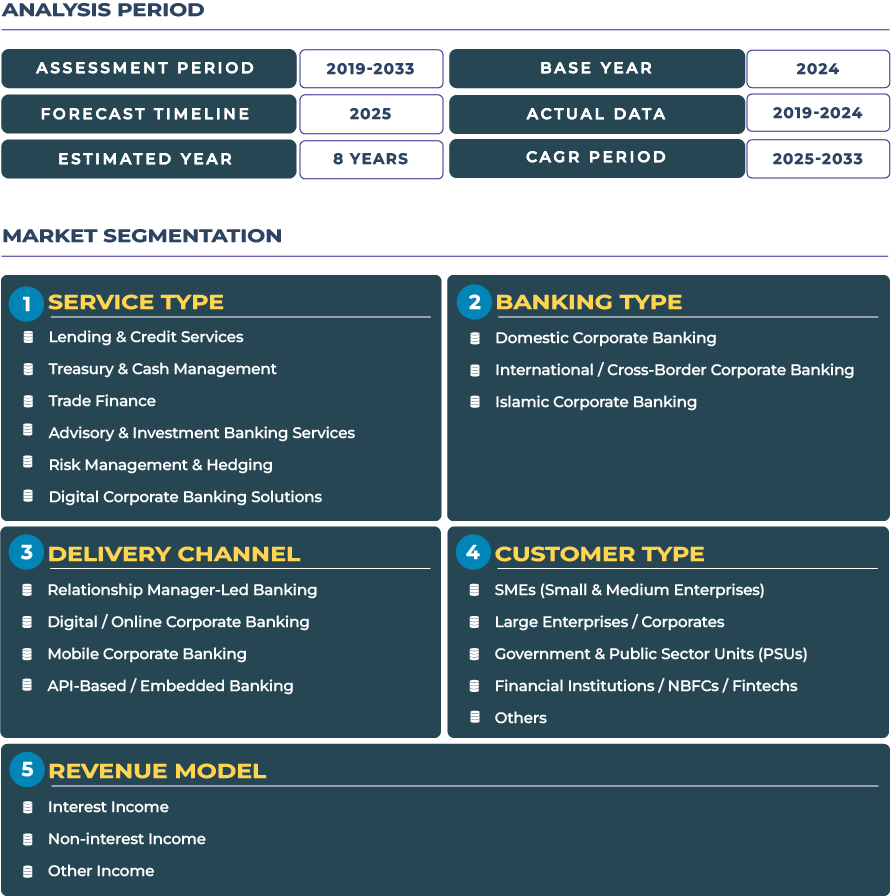Malaysia Corporate Banking Market Accelerates as Trade Digitalization Reshapes Client Expectations
Malaysia corporate banking market is undergoing a decisive shift as enterprises demand faster, tech-enabled financial services and streamlined trade finance solutions. The market was valued at USD 21.4 billion in 2024 and is projected to reach USD 41.3 billion by 2033, driven by an 8.2% CAGR fueled by digital lending, regional trade activity, and SME financing demand. Corporate banks are no longer competing only on relationship management but on digital infrastructure, supply chain integration, and advisory capabilities across fast-scaling industries.
Note:* The market size refers to the total revenue generated by banks through interest income, non-interest income, and other ancillary sources.
Expanding Trade Corridors and Investment Flows Reinforce Corporate Banking Growth
Malaysia’s increasing trade volumes with China, ASEAN, and the Middle East are reshaping banking service portfolios. Corporates now expect automated LC issuance, cross-border cash pooling, and real-time payments through standardized digital platforms. Institutions like Bank Negara Malaysia are supporting trade modernization through eKYC guidelines and sandbox programs. Rising FDI in manufacturing, logistics, and green energy further boosts working capital financing, syndicated lending, and treasury operations.
SME Financing and Supply Chain Lending Gain Strong Traction
Over 97% of Malaysian businesses fall under SMEs, and banks are increasingly building specialized digital credit products to address financing gaps. Government-backed schemes and fintech collaborations are pushing banks to use transaction data, e-commerce records, and supplier networks for credit scoring. This shift is creating market advantages for banks offering faster disbursements, lower collateral requirements, and receivables financing tailored to trade-focused SMEs.
Digital Trade Finance Platforms Redefine Transaction Banking
The introduction of digital trade finance platforms marks a pivotal change in how banks are serving clients. Cloud-based LC management, automated invoice processing, and blockchain-backed documentation systems are reducing compliance complexity and fraud exposure. Corporate clients are prioritizing paperless submission, end-to-end workflow visibility, and integration with ERP systems, raising competitive stakes for banks that lag in tech adoption. These platforms are becoming new relationship anchors for banks targeting high-volume exporters and logistics operators.
Key Drivers: Regulatory Push, Digital Ecosystems, and Capital Expansion
Malaysia’s regulators are accelerating digital adoption through licensing frameworks for virtual banks and open banking APIs. Funding support from export-led sectors, industrial upgrading plans, and Islamic finance structures is further catalyzing market growth. Banks are investing in analytics-driven risk underwriting and digitized onboarding to shorten credit cycles and increase cross-sell potential. Combined with industry consolidation and ecosystem partnerships, these drivers are shaping stronger transaction banking models.
Market Restraints: Cybersecurity Gaps, Legacy Tech, and Compliance Burdens
Despite strong growth, banks face challenges linking legacy infrastructure with new platforms. Integration costs, cybersecurity risks, and increased due diligence requirements under anti-money laundering regulations slow execution speed. SMEs still struggle with documentation readiness and digital literacy, delaying trade finance adoption. Banks also face higher operating costs due to reporting mandates and cross-border risk assessments, impacting operational agility and digital transformation investments.
Rising Trends: ESG Lending, Islamic Corporate Finance, and AI-Driven Treasury Tools
Malaysia’s sustainability agenda is expanding green trade financing and ESG-linked working capital products. Growing investor interest in Shariah-compliant corporate banking is propelling new sukuk issuances, profit-based financing, and halal supply chain solutions. Banks are deploying AI for liquidity forecasting, FX hedging automation, and credit risk mapping. Treasury digitization is gaining traction among mid-corporates seeking integrated cash management and forecasting tools.
Opportunities: Cross-Border Expansion, Digital Islamic Banking, and Embedded Finance
As Malaysian banks expand into Indonesia, Vietnam, and Singapore, cross-border digital treasury products and multi-currency liquidity services are gaining strategic importance. Embedded finance models are surfacing through partnerships with ERP providers, e-marketplaces, and logistics platforms, offering seamless access to credit and payments. Islamic digital corporate banking platforms are emerging as competitive differentiators for banks targeting energy, infrastructure, and manufacturing clients.
Competitive Landscape: Incumbents, New Entrants, and Technology Partnerships
Major players such as Malayan Banking Berhad (Maybank), CIMB, RHB, and Public Bank dominate the market with strong balance sheets and diversified portfolios. However, specialized providers and fintech alliances are eroding mid-market share by focusing on automation, API-led integrations, and niche financing products. Local and regional banks are boosting competitiveness through partnerships in trade digitization, cash management APIs, and supply chain financing networks.
Regulatory Ecosystem Strengthens Stability And Innovation
Guidelines from Bank Negara Malaysia are promoting responsible digitization while safeguarding liquidity and capital adequacy. Open banking advancements, digital identity frameworks, and eTrade initiatives are improving transparency and accelerating onboarding. The regulatory environment is also supporting Islamic corporate banking models, enabling wider portfolio diversification for banks targeting manufacturing, construction, and export clients.
Future Outlook: Consolidation and Digital Depth Will Define the Next Growth Phase
Malaysia corporate banking market is entering a phase where scale and technology depth will determine leadership. The convergence of digital trade finance, SME credit innovation, and ESG-linked corporate products will create new revenue pools. Banks that boost platform-based lending, embedded treasury services, and data-driven advisory models will outperform. As competition intensifies across ASEAN, those integrating Islamic finance capabilities with cross-border digital banking will gain lasting strategic advantages.







